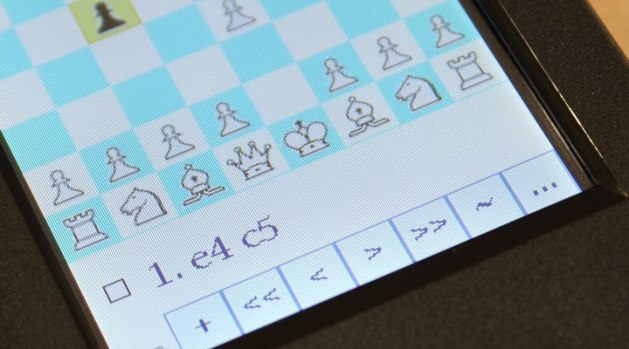Tracking game notation in chess means different things to different people. For some, it is a necessary evil for tracking the outcome of tournament matches, while for others it is a lifeblood of the game in which a player can re-live his or her past mistakes and triumphs. Regardless, tracking chess notation is essential for a player wanting to improve. For me, I rarely (if ever) play a chess game without somehow annotating it. Part of this might be my tendency toward obsessive behavior, but it also has to do with my desire to have a vast archive of my games in which I can reference for improvement. Chessbase 12 is my database system of choice, although I really wish they would make a verso for OS X because I hate having to run it in a Windows 7 virtual machine, but I digress.
Annotating a chess game in a setting such as a park or an office can be challenging, especially if you’re playing blitz or something faster. I began annotating my games with one of those $2 scoresheet pads from The Chess Store and eventually I switched to the Tabiya Chess Scorebook from Precision Chess. These books are available for about $10 on Amazon.com and are great for keeping track of an individual tournament or a thematic game set. However, as a technophile, I wanted some way to integrate technology into my game annotations. I was inspired recently when I visited the US Chess Federation (USCF) website and noticed the Monroi advertisement at the bottom of the page. Yes, unfortunately, sometimes internet advertising works. I had checked out Monroi some years ago and found their device to be significantly bulky in appearance and extremely overpriced. I was disappointed to see that in the few years since I had visited the site that nothing had really changed. There has not been a new version of the Monroi PCM in almost eight years and the price remains excruciatingly high for a handheld chess board.
I spent almost an entire day researching the Monroi system and eventually came across two of its competitors. I had never heard of these programs and it is most likely because one of them is new and the other is designed for older iPaq and Windows Mobile devices. eNotate is a digital chess program that installs onto a handheld computer running Microsoft Windows Mobile 5 or 6, such as the HP iPaq. The program locks out all other services while active, which prevents the user from switching back and forth between a chess engine and the notation program. The price is very attractive ($60), but it requires a handheld device, which the cheapest is the HP iPaq retailing on Amazon.com for around $100. I decided to pass on eNotate for the time being and see what else was available. That is when I discovered PlyCounter.
I had never heard of PlyCounter and that is because it is a relatively new device created by a chess player from Dallas, Texas. Not that its creator being from Texas is a real reason why I would never have heard of it, but I think it is important to note that this product is the result of American entrepreneurship in a market desperately in need of innovation. On its website, this little device boasts of its USCF certification and assures its buyers that it is currently undergoing review for FIDE certification as well. Currently, PlyCounter retails on its website for $169 and after comparing the cost of eNotate and a handheld device to install and use it, I decided to purchase a PlyCounter for annotating my games.

At first glance, the PlyCounter device can be a shock to the system, especially in a day of millimeter-thin iPhones, iPads, and laptops. It closely resembles an old-style Palm Pilot in size and form, and the display brings back some nostalgic memories for those of us that grew up playing the original Game Boy, Game Gear, or other devices with miniature screens and low resolution. If this device was being reviewed by a technology site or compared to some of the handheld sets being produced by Apple or Samsung today, it would be utterly destroyed for its appearance. For example, the PlyCounter is thicker than my Macbook Air closed, with a plastic cover over it. However, the world of chess technology is not driven by the need for higher resolutions, micro-thin designs, and unnecessary gimmick features. PlyCounter is a simple device that does exactly what it says it does, and it performs its functions exceptionally well.

PlyCounter is a personal chess manager that is very similar to the Monroi PCM, but with some added bonuses and without some of the additional features. The one thing that most people will notice is that it does not come with an SD card slot. Therefore, any chess games annotated on the device must be downloaded through a USB connection using the PlyCounter download software, which is available from the PlyCounter website. This is a minor inconvenience since the device’s connector uses a standard micro-USB adapter, which most people already own and use to recharge their Kindle or other similar devices. I keep one of these cables plugged in to my iMac, so it takes less than a minute to connect the PlyCounter and download my games in PGN format. This brings me to the next point, which is a lack of wifi. Wireless connectivity for transferring games would have been a welcome addition to the PlyCounter, but I can understand that it was most likely not included for security reasons. Without integrated wifi, the device is at the mercy of a laptop or desktop terminal to transfer and receive information without user input, so that reduces the chances that a person could adapt it to receive information from a chess engine on a wifi connection.

These are minor issues that I believe every device has to deal with. There are many positive aspects to the PlyCounter that have made it my notation tool of choice. First, it has an incredibly bright and responsive touch screen. The device comes with a telescoping stylus and additional styluses can be purchased from the PlyCounter website for $2 each. I highly recommend that anyone purchasing the device stock up on spare styluses…just in case! Moves are simple to input and in accordance with USCF and FIDE specs, the device allows for players to input incorrect moves. Therefore, where you click…your pieces will go. This is important to avoid the perception that the device is providing any assistance to tournament players by preventing them from making illegal moves. The tap-move methodology of the device takes a few minutes to get used to, but quickly becomes second nature after annotating a game or two. In addition to the responsive board, the device also includes a place for the player to input their USCF and FIDE ratings along with their federation ID numbers. Each device will come belonging to Ruy Lopez by default.

As you can tell, I am in love with my PlyCounter. It is simple, intuitive, and provides a relatively easy way to export my games to PGN for inclusion in Chessbase or to provide to a tournament director. For $169 I do not believe that you can do better for certified digital chess notation that this little device. If you want t spend an extra $150, the Monroi PCM includes an SD card and wireless connectivity, but the tradeoffs are probably not worth the extra dough unless you need something that is FIDE certified. I am confident that FIDE will eventually certify the PlyCounter and that it will become a mainstay at tournaments around the world. Rightfully so, it is the perfect companion for the chess annotator on the go or for someone looking for a practical way to record their chess notation. Chess notation tools are different for everyone, but I am convinced that unless you require a Monroi PCM to interface with a tournament system, the PlyCounter is the way to go.
Technical Specifications
| Monroi PCM | PlyCounter |
|---|---|
| Size: 3.1in x 4.69in x 0.70in | Size: 4in x 2.54in x 0.75in |
| Display: 240 x 320 LCD | Display: 240 x 320 TFT |
| Weight: 7.05 ounces | Weight: 4.3 ounces |
| Memory: 4MB (50 games) | Memory: 4GB (10 million games) |
| Wireless: Yes | Wireless: No |
| Battery: Internal, USB-charged | Battery: Internal, USB-charged |
| File Format: PGN | File Format: PGN |
| Certification: USCF, FIDE | Certification: USCF, FIDE-pending |
| Price: $359 | Price: $169 |
| Purchase | Purchase |
PlyCounter Final Verdict: ♟ ♟ ♟ ♟ ♟

